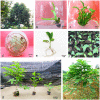An efficient micropropagation protocol for an endangered ornamental tree species (Magnolia sirindhorniae Noot. & Chalermglin) and assessment of genetic uniformity through DNA markers
- PMID: 31270420
- PMCID: PMC6610120
- DOI: 10.1038/s41598-019-46050-w
An efficient micropropagation protocol for an endangered ornamental tree species (Magnolia sirindhorniae Noot. & Chalermglin) and assessment of genetic uniformity through DNA markers
Abstract
Magnolia sirindhorniae Noot. & Chalermglin is an endangered species with high ornamental and commercial value that needs to be urgently protected and judiciously commercialized. In this study, a protocol for efficient regeneration of this species is standardized. The lateral buds of the M. sirindhorniae plant were used as an explant. Half-strength Murashige and Skoog (MS) medium supplemented with 2.0 mg/L 6-benzyladenine (BA), 0.1 mg/L α-naphthaleneacetic acid (NAA), and 2.0 mg/L gibberellic acid (GA3) was found to be the optimal medium for shoot induction. The maximum shoot multiplication rate (310%) was obtained on Douglas-fir cotyledon revised medium (DCR) fortified with 0.2 mg/L BA, 0.01 mg/L NAA, and additives. The half-strength DCR medium supplemented with 0.5 mg/L NAA and 0.5 mg/L indole-3-butyric acid (IBA) supported the maximum rate (85.0%) of in vitro root induction. After a simple acclimatization process, the survival rate of plantlets in a substrate mixture of sterile perlite and peat soil (1:3; v/v) was 90.2%. DNA markers were used for assessment of genetic uniformity, confirming the genetic uniformity and stability of regenerated plants of M. sirindhorniae. Thus, the described protocol can safely be applied for large scale propagation of this imperative plant.
Conflict of interest statement
The authors declare no competing interests.
Figures



Similar articles
-
An efficient and reproducible method for in vitro clonal multiplication of Rauvolfia tetraphylla L. and evaluation of genetic stability using DNA-based markers.Appl Biochem Biotechnol. 2012 Dec;168(7):1739-52. doi: 10.1007/s12010-012-9893-3. Epub 2012 Sep 12. Appl Biochem Biotechnol. 2012. PMID: 22968591
-
Indirect Regeneration and Assessment of Genetic Fidelity of Acclimated Plantlets by SCoT, ISSR, and RAPD Markers in Rauwolfia tetraphylla L.: An Endangered Medicinal Plant.Biomed Res Int. 2019 Apr 11;2019:3698742. doi: 10.1155/2019/3698742. eCollection 2019. Biomed Res Int. 2019. PMID: 31111050 Free PMC article.
-
Interactive Effects of Growth Regulators, Carbon Sources, pH on Plant Regeneration and Assessment of Genetic Fidelity Using Single Primer Amplification Reaction (SPARS) Techniques in Withania somnifera L.Appl Biochem Biotechnol. 2015 Sep;177(1):118-36. doi: 10.1007/s12010-015-1732-x. Epub 2015 Jul 8. Appl Biochem Biotechnol. 2015. PMID: 26152820
-
Gerbera micropropagation.Biotechnol Adv. 2013 Dec;31(8):1344-57. doi: 10.1016/j.biotechadv.2013.05.008. Epub 2013 Jun 4. Biotechnol Adv. 2013. PMID: 23743093 Review.
-
Microbulb and plantlet formation of a native bulbous flower, Lilium monodelphum M. Bieb, var. Armenum, through tissue culture propagation.Biotechnol Rep (Amst). 2021 Aug 8;32:e00665. doi: 10.1016/j.btre.2021.e00665. eCollection 2021 Dec. Biotechnol Rep (Amst). 2021. PMID: 34540598 Free PMC article. Review.
Cited by
-
Importance of Media Composition and Explant Type in Cannabis sativa Tissue Culture.Plants (Basel). 2024 Sep 10;13(18):2544. doi: 10.3390/plants13182544. Plants (Basel). 2024. PMID: 39339519 Free PMC article.
-
In Vitro Technology in Plant Conservation: Relevance to Biocultural Diversity.Plants (Basel). 2022 Feb 12;11(4):503. doi: 10.3390/plants11040503. Plants (Basel). 2022. PMID: 35214833 Free PMC article. Review.
-
Genetic Stability, Phenolic, Flavonoid, Ferulic Acid Contents, and Antioxidant Activity of Micropropagated Lycium schweinfurthii Plants.Plants (Basel). 2021 Oct 1;10(10):2089. doi: 10.3390/plants10102089. Plants (Basel). 2021. PMID: 34685900 Free PMC article.
-
Production of secondary metabolites using tissue culture-based biotechnological applications.Front Plant Sci. 2023 Jun 29;14:1132555. doi: 10.3389/fpls.2023.1132555. eCollection 2023. Front Plant Sci. 2023. PMID: 37457343 Free PMC article. Review.
-
Micropropagation, encapsulation, physiological, and genetic homogeneity assessment in Casuarina equisetifolia.Front Plant Sci. 2022 Aug 18;13:905444. doi: 10.3389/fpls.2022.905444. eCollection 2022. Front Plant Sci. 2022. PMID: 36061770 Free PMC article.
References
-
- Lee YJ, et al. Therapeutic applications of compounds in the Magnolia family. Pharmacol. Ther. 2011;130(2):157–176. - PubMed
-
- Farag MA, El Din RS, Fahmy S. Headspace analysis of volatile compounds coupled to chemometrics in leaves from the Magnoliaceae family. Rec. Nat. Prod. 2015;9(1):153–158.
-
- Morshedloo MR, Quassinti L, Bramucci M, Lupidi G, Maggi F. Chemical composition, antioxidant activity and cytotoxicity on tumour cells of the essential oil from flowers of Magnolia grandiflora cultivated in Iran. Nat. Prod. Res. 2017;31(24):2857–2864. - PubMed
-
- Nooteboom HP, Chalermglin P. The Magnoliaceae of Thailand. Thai Forest Bulletin (Botany). 2009;37:111–138.
-
- Li, J. Essential oil extraction of Magnoliaceae plants and GC - MS analysis. Doctoral dissertation, South China University of Technology (2011).
Publication types
MeSH terms
Substances
LinkOut - more resources
Full Text Sources
Other Literature Sources

